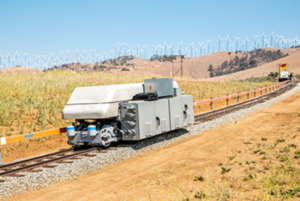
Compared to the mechanics of chemical batteries, the idea behind rail storage is simple. During periods of low electricity demand, power is dispatched from the nearby grid to pull a chain of weighted train cars uphill. And there they will sit—losing no power to degradation—until the grid has a period of high power demand. Then they are sent rolling downhill. Their momentum sends electrons back to the grid through a system of regenerative braking that uses the turning power of the wheels to generate electricity.
“They go up, they go down, Slinky fashion,” said Francesca Cava, chief operating officer at Advanced Rail Energy Storage North America, the company behind the Nevada project. “For the most part, the technology we’re using is over a hundred years old—we’re not waiting for any scientific breakthroughs to be profitable.”
The process is a way of storing and releasing power, vital aspects of any power system with high penetrations of variable solar and wind energy.
The only forces exploited by rail storage—conceptually similar to pumped-storage hydroelectric systems—are gravity and friction. But unlike with pumped hydro, the train cars and their underlying rails don’t need a conveniently located waterway or reservoir, making them far attractive to an arid region like western Nevada.
ARES predicts its operation will cost only half of what a pumped hydro project with similar energy output would require, and should have a much smaller environmental footprint.
Little engine becomes a power player
Currently, only a quarter-scale, 800-foot pilot project is in operation. But ARES has begun the planning process for its first commercial-scale project, which it plans to build near the California boarder of Nevada in partnership with Valley Electric Association Inc. (VEA).
The Nevada-based VEA recently opted to tie in with the much larger California Independent System Operator, the first non-California-based utility to do so. ARES’ applications fit both VEA’s regional markets and the needs of the larger California ISO, said Tom Husted, CEO of VEA.
“Obviously, to have this technology first developed and deployed in southern Nevada is something we’re excited about,” he said. “Because we’re located in the Sun Belt, this fits nicely into our grid and has the potential to further the renewable opportunities we have here.”
The region is in need of storage to accompany its ambitious renewable energy targets, and it is pursuing options including new combined-cycle gas plants to meet expected oscillations in supply (ClimateWire, Nov. 12, 2013). California law requires that solar, wind and other renewable sources make up 33 percent of the electricity supply by 2020.
Putting weight to work
In a different life, the train cars to be deployed in the utility-scale project would be employed in Australian ore mining operations. They are designed specifically for durability, Cava explained. On a typical trip, each will haul about 230 tons of rock and cement up a gradual, 6- to 9-degree slope. After 3,000 feet of elevation above the start of their trip, they’ll be docked in a yard, where they wait until needed.
During slow periods, the cars may discharge their cargo at the top and go back down, empty, for more, as heavier loads allow for increased generation capacity.
Each will be equipped with a 2-megawatt generator. The same piece of equipment functions both as a motor and as a generator, depending on the direction it is being turned, said Cava.
Ramp-up times average from five to 10 seconds. That’s not quite as good as a chemical battery, which can output its full capacity immediately, but is significantly better than the rate of a combined-cycle natural gas plant, which ramps up about 8 percent of its output per minute.
Conventional coal plants, by contrast, can take hours to ramp up to full output, making them ill-suited to counterbalance the intermittency of renewable energy.
“Our operations are larger than batteries, but smaller than conventional generation,” Cava said. Although still breaking ground on its first project, the company has registered significant interest from other localities, including some international interests, she said.
read more original article Scientific America
